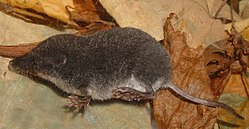| Soricinae [1] Temporal range: Early Oligocene to Recent | |
|---|---|
 | |
| Baird's shrew (Sorex bairdi) | |
| Scientific classification | |
| Domain: | Eukaryota |
| Kingdom: | Animalia |
| Phylum: | Chordata |
| Class: | Mammalia |
| Order: | Eulipotyphla |
| Family: | Soricidae |
| Subfamily: | Soricinae Fischer von Waldheim, 1817 |
| Tribes | |
The red-toothed shrews of the subfamily Soricinae are one of three living subfamilies of shrews, along with Crocidurinae (white-toothed shrews) and Myosoricinae (African white-toothed shrews). In addition, the family contains the extinct subfamilies Limnoecinae, Crocidosoricinae, Allosoricinae and Heterosoricinae. These species are typically found in North America, northern South America, Europe and northern Asia. The enamel of the tips of their teeth is reddish due to iron pigment. The iron deposits serve to harden the enamel and are concentrated in those parts of the teeth most subject to wear. [2] Members of the genera Chimarrogale , Nectogale , Neomys (Nectogalini) and some members of Sorex (Soricini) are known as water shrews, due to having a semi-aquatic lifestyle.
